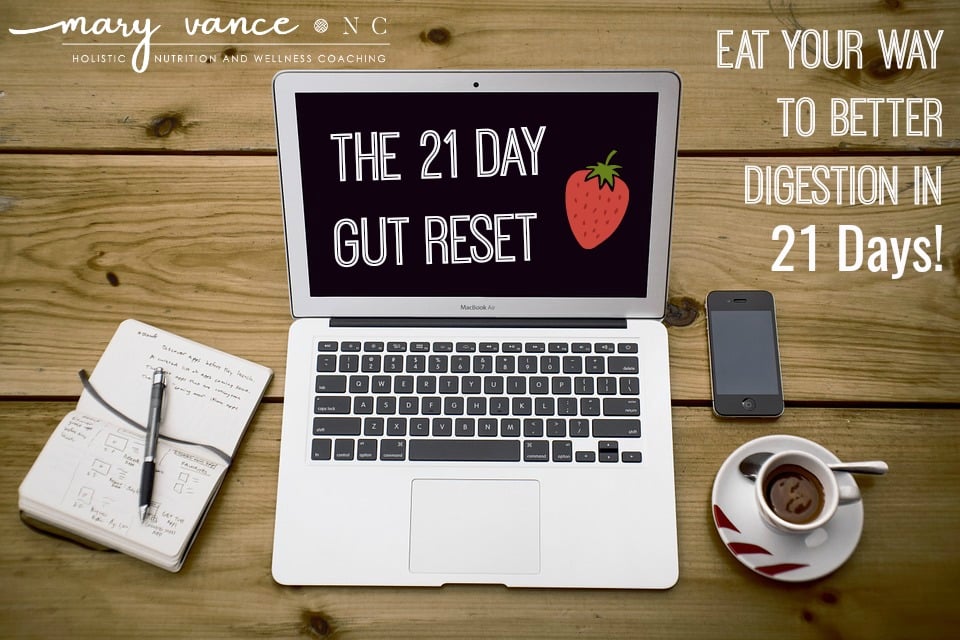
You want to know how to get rid of your gut? Quickly, without really trying? I have the secret for you.
The calories in-calories burned method of losing weight is considered quite antiquated now, because the body really functions as more of a chemistry lab than a bank account. Weight loss is a hormonal game (estrogen, thyroid, ghrelin, leptin, cortisol), a game of blood sugar balance, proper digestion, assessment of any hidden food sensitivities, eating the right foods for your physiology, avoiding excess stress, getting proper sleep, and the right kind of exercise.
Yes, you may lose weight following a restricted calorie plan or counting points on Weight Watchers, but it’s not sustainable, usually because the body perceives restricted calories as a stress, which affects cortisol levels, triggering increased fat storage in the end.
Additionally, leptin plays a role in regulating body weight, and losing weight/reducing calories causes a marked decrease in leptin levels, which may in turn increase appetite. The notion of “going on a diet” only to go off it and transition back into old habits is not a long term solution. The key is to determine the underlying causes of what’s triggering weight gain or preventing weight loss and finding the right type of long term diet.
How to Get Rid of Your Gut
The easiest way to get rid of your gut (without really trying) is to stop eating gluten. Gluten is the sticky protein found in wheat, rye, barley, and spelt. Research is showing gluten’s contribution to the rise in health problems from digestive issues to diabetes. Typically it was accepted that you only needed to avoid gluten if you had celiac disease (a severe gluten allergy). Or if you were gluten sensitive (a genetic, inherited auto-immune inflammatory response to gluten).
But now we know that it goes a bit beyond that. Wheat Belly author Dr. William Davis explains that gluten (especially in wheat) today isn’t the same stuff our ancestors were eating. And for that matter, our ancestors (before the Agricultural Revolution) probably didn’t eat many grains, and if they did, they prepared them properly, soaking/sprouting/fermenting them.
Dr Davis says, “The gliadin protein of wheat has been modified by geneticists through their work to increase yield. This work, performed mostly in the 1970s, yielded a form of gliadin that is several amino acids different, but increased the appetite-stimulating properties of wheat. Modern wheat, a high-yield, semi-dwarf strain (not the 4 1/2-foot tall “amber waves of grain” everyone thinks of) is now, in effect, an appetite-stimulant that increases calorie intake 400 calories per day.”
Gluten increases appetite. And if you happen to have a gluten sensitivity (and it’s estimated that 1 in 33 do), the gluteomorphins–peptides that are produced as gluten is breaking down–plug up receptors in the brain that give the person a pleasurable drugged feeling, like scaled down heroin or morphine. It can be addicting, and that drives cravings and binge behavior. But what’s also occurring is inflammation from the damage gluten inflicts in the intestinal tract. This inflammation drives weight gain/prevents weight loss, causes malabsorption in the intestinal tract, and the cravings go way beyond will power–it’s a physiological drive to get the rush provided by the gluteomorphins.
In addition, gluten affects blood sugar (two slices of whole wheat bread increase blood sugar more than table sugar, higher than many candy bars), which raises insulin, triggering fat storage. Chronic high insulin also leads to insulin resistance (meaning glucose cannot get into cells), which leads to diabetes. Ever notice how the base of that stupid USDA food pyramid recommends that whole grains be the base of our diet? What do they use to fatten cattle? Grain.
Number two way to get rid of your gut: once you’ve kicked the gluten, focus primarily on good protein (meat–wild fish, organic chicken, grass fed beef/lamb/buffalo, eggs) and lots of veggies of all kinds. Grains and grain-based foods (even the gluten free varieties like rice, quinoa, amaranth, millet, etc) all break down into sugars over time, and excess sugar is stored as fat. So even if you’re eating gluten free, don’t pig out on gluten free subs for your favorite foods.
This means reduce or eliminate gluten free breads, cookies, pasta, etc. They’re made with gluten free grains and usually contain quite a bit of sugar, the other major demon that drives weight gain. You only need a little less than a teaspoon of circulating glucose in your bloodstream at any time, and the body regulates this.
If you take in more sugar than your body needs for energy, the excess is converted to lipids and stored as fat. Focus on lots of veggies and good fats, too. Read more about why eating fat helps you lose weight here.Stick to the protein/vegetable model and your body will burn stored fat for energy rather than store fat. You’ll switch from fat storage mode to fat burning mode.
Not to neglect the other factors at play here. Digestion: Studies show that beneficial bacteria in the gut is necessary for weight maintenance. Also, eliminating those foods to which you have intolerances will decrease inflammation and malabsorption in the gut.
Sleep: lack of sleep drives weight gain. Your body considers lack of sleep (less than 7 or 8 hours) a stress, driving cortisol levels up, increasing blood sugar and appetite/sugar cravings. High cortisol can prevent restful sleep, or lack of sleep can cause high cortisol.
Toxicity: toxins are stored in fat tissue, and the body is reluctant to burn the stored fat that contains toxins. Reduce your total toxic load by using natural products, eating organic, and doing a cleanse once or twice a year to encourage release of toxins.
Click here to download my ebook and get started on a 21-day plan to jumpstart weight loss!

Mary Vance is a Certified Nutrition Consultant and author specializing in digestive health. She combines a science-based approach with natural therapies to rebalance the body. In addition to her 1:1 coaching, she offers courses to help you heal your gut and improve your health. Mary lives in San Francisco and Lake Tahoe in Northern California. Read more about her coaching practice here and her background here.





I’m curious that you say quinoa, millet, etc are grains – I’ve read in many places that they are seeds and a great addition to a paleo diet. thoughts?
I’ve read that those seeds (quinoa, millet etc) are okay on Paleo but unless you work out quite a bit, are not necessary and can hinder weight loss efforts. Still, if you need to have a “grain-type substance” these are your best choices.
There are no grains on a Paleo diet, and this includes these seed grains. No grains, no legumes, no dairy. Dairy is Primal (close to Paleo), but usually raw dairy.